| Author | W.P.C. Barton | |
| Distribution | Formerly collected at a couple of sites in the extreme northwestern corner of the Coastal Plain and the adjacent Piedmont, in Halifax and Northampton counties. It is of historical occurrence in the state, with the last record in 1958. Sadly, no one alive has ever seen the species in NC.
Despite its limited range in NC, it has a quite wide range across the eastern U.S. but is rare everywhere. It ranges north to MA and MI, and south to southern GA and AR. However, there are only a handful of county records in each of the 20 states where it has been found. | |
| Abundance | Historical only; considered extirpated. However, as there are current records north and south of the state (in VA and SC), we can hope that someone will re-find it in the state, as suitable habitat appears to be present. Why this species is so scarce across its large range is a complete mystery; it must have more exacting habitat requirements than thought. This is a State Species Concern species.
| |
| Habitat | This species occurs in wet depression meadows, natural ponds, “boggy” areas, and apparently also in openings in marshes. It seems to favor isolated, non-flowing, non-connected wetlands. |
| Phenology | Blooms and fruits in July and August. | |
| Identification | This is a colonial, perennial herb that grows to about 2 feet tall, typically in moderate stands, usually in shallow water. The leaves are dark green, shiny, and lanceolate to narrowly elliptic, with revolute margins and a sunken mid-vein, to about 2 inches long. It has numerous 5-petaled yellow flowers that are about 2/3-inch across and form a wide, flattened or slightly domed inflorescence. The species, as with many St. John’s-worts, could be easily overlooked when not in bloom. However, if you see a colony of yellow, 5-petaled flowers growing on low plants in shallow water, it is worth checking out. There is no obvious reason why the species should be completely gone forever in NC. It is currently still considered extant in GA, SC, VA, and TN –- the four states that surround NC. | |
| Taxonomic Comments | None
| |
| Other Common Name(s) | Bog St. John’s-wort | |
| State Rank | SH | |
| Global Rank | G3 | |
| State Status | SC-H | |
| US Status | | |
| USACE-agcp | OBL link |
| USACE-emp | OBL link |

